Home / Reagent Friday: NBS (N-Bromo Succinimide)
Organic Reagents
Reagent Friday: NBS (N-Bromo Succinimide)
Last updated: February 12th, 2025 |
N-Bromosuccinimide (NBS) As A Reagent In Organic Chemistry
In a blatant plug for the Reagent Guide, each Friday I profile a different reagent that is commonly encountered in Org 1/ Org 2.
Table of Contents
1. N-Bromosuccinimide Is A More Convenient Alternative To Bromine (Br2)
If you’ve ever had the “pleasure” of working with bromine (Br2), you’ll know that this dense orange liquid is a pain in the butt for two reasons. First of all, it fumes like a bastard. Once you open the bottle, orange fumes start spewing everywhere, and if you haven’t put the bottle deep into the fume hood, you will soon be savoring the unforgettable aroma of Br2 (mixed with HBr) in your nostrils. Secondly, it’s extremely dense (d=3.19) and therefore drops of it tend to fall from whatever you’re using to dispense it with, Jackson Pollock style, leaving a little trail of violently fuming orange puddles behind. [Edit: Thank you to commenter Dr. Fred Schreiber for pointing out that this behavior is due to the high vapor pressure of Br2, not the density.]
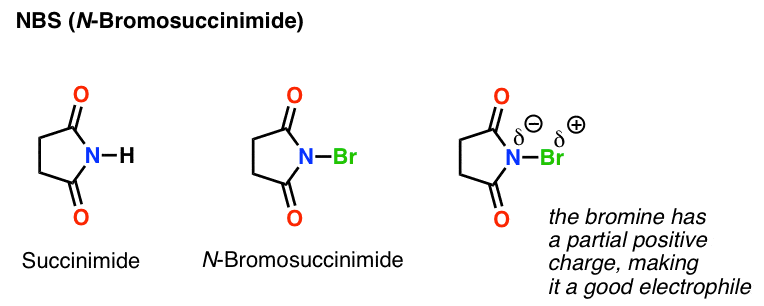
In contrast, NBS (N-bromo succinimide) is a gleaming white crystalline solid and easy as pie to work with. But don’t be deceived. It packs a punch. It will do many of the same reactions as bromine – attached to the electron-withdrawing nitrogen of succinimide, the bromine has a partial positive charge and is therefore electrophilic.
There are two major reactions NBS is used for in Org 1/ Org 2: allylic bromination (the most common) and also as a replacement for Br2 in the formation of bromohydrins.
2. NBS As A Reagent For Allylic Bromination
Allylic bromination is the replacement of a hydrogen on a carbon adjacent to a double bond (or aromatic ring, in which case it’s called benzylic bromination). NBS is used as a substitute for Br2 in these cases since Br2 tends to react with double bonds to form dibromides. The advantage of NBS is that it provides a low-level concentration of Br2, and bromination of the double bond doesn’t compete as much.
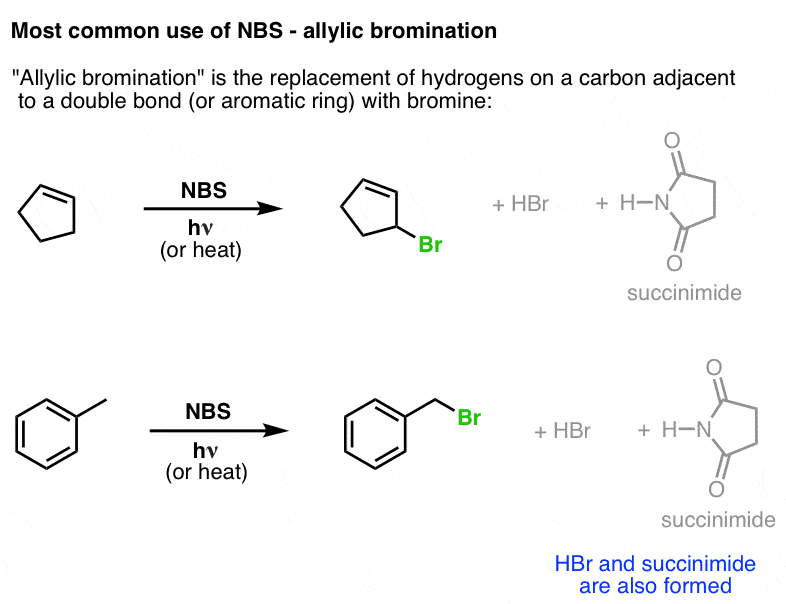
3. Allylic Bromination With NBS: How It Works
Once Br2 is formed, the reaction proceeds much like other free-radical halogenation reactions: homolytic cleavage of the Br2 with light or head (initiation), followed by abstraction of the allylic H (propagation step #1) and subsequent reaction of this radical with another equivalent of Br2 to give the desired product. The remaining Br radical then reacts with another equivalent of the hydrocarbon in this chain reaction until the limiting reagent is consumed.
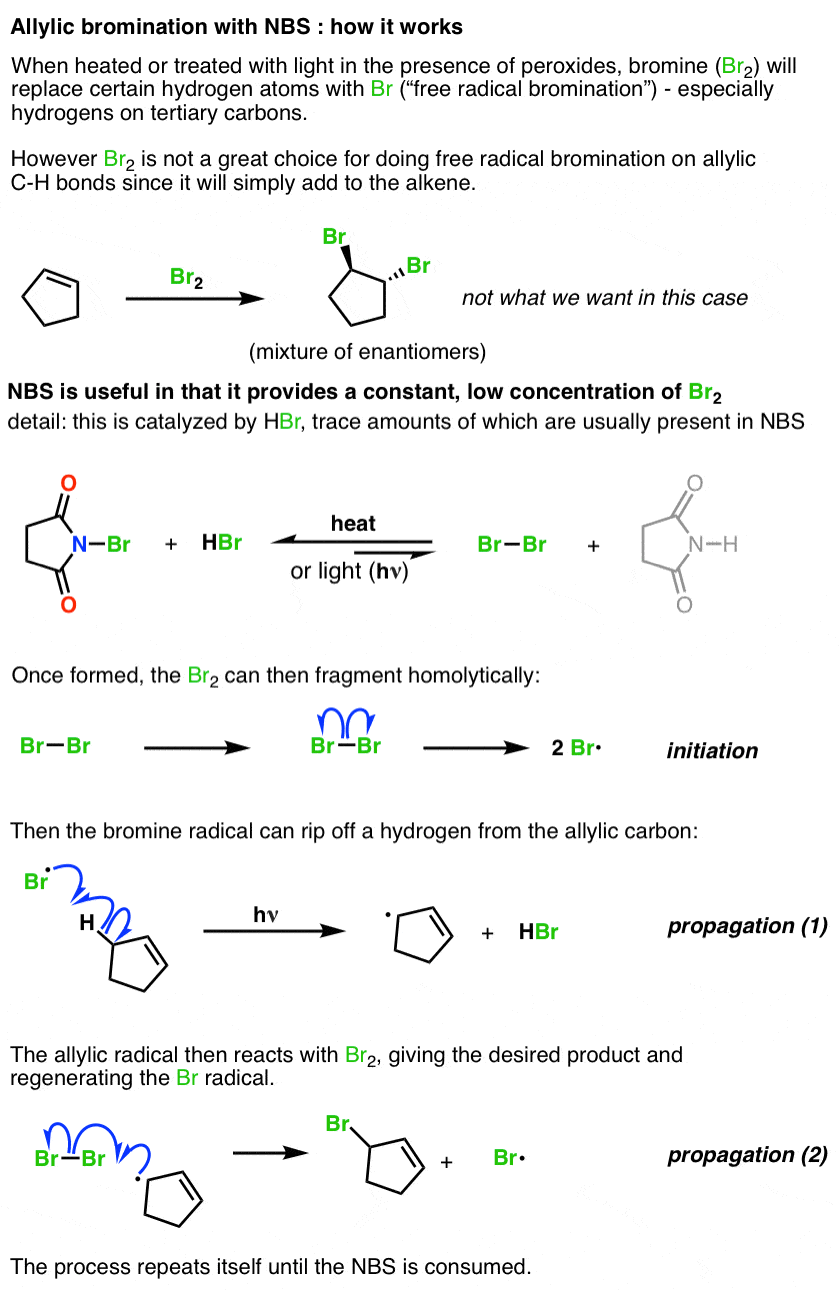
4. NBS As A Reagent For Bromohydrin Formation From Alkenes
NBS can also serve as a replacement for Br2 in formation of halohydrins.

Recall that alkenes react with Br2 to form “bromonium ions“, which are 3-atom rings with a positive charge on the bromine. Well, NBS will also form bromonium ions with alkenes. When water (or an alcohol) is used as a solvent, it will attack the bromonium ion, resulting in formation of the halohydrin. Note that the stereochemistry is always “trans“.
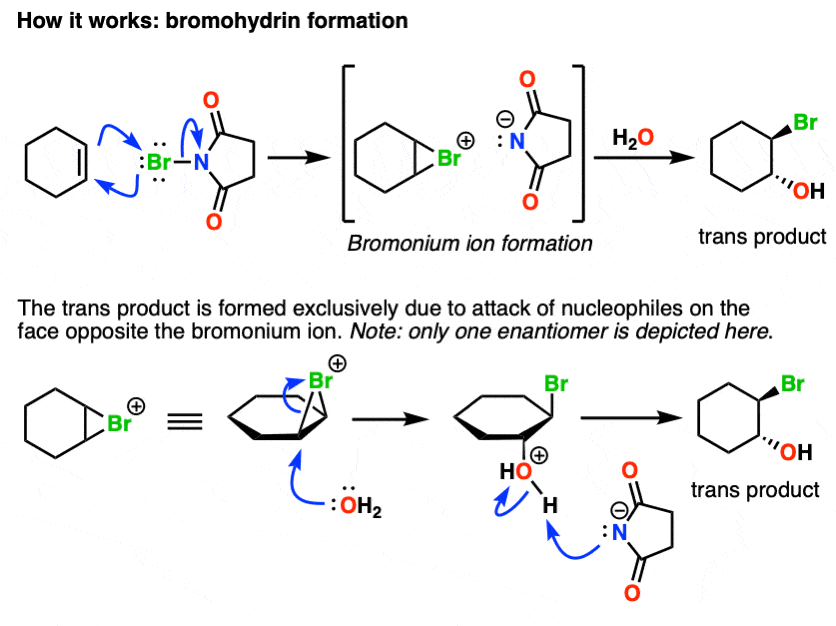
There are tons of other uses for NBS beyond what you see in Org 1/Org 2, of course, but those are the basics.
P.S. You can read about the chemistry of NBS and more than 80 other reagents in undergraduate organic chemistry in the “Organic Chemistry Reagent Guide”, available here as a downloadable PDF.
Notes
Related Articles
- Allylic Bromination
- Reactions on the “Benzylic” Carbon: Bromination And Oxidation
- Halogenation of Alkenes and Halohydrin Formation
- Oxymercuration Demercuration of Alkenes
- Hydration of Alkenes With Aqueous Acid
- Electrophilic Aromatic Substitutions (1) – Halogenation of Benzene
- Alkene Addition Pattern #2: The “Three-Membered Ring” Pathway
Quiz Yourself!
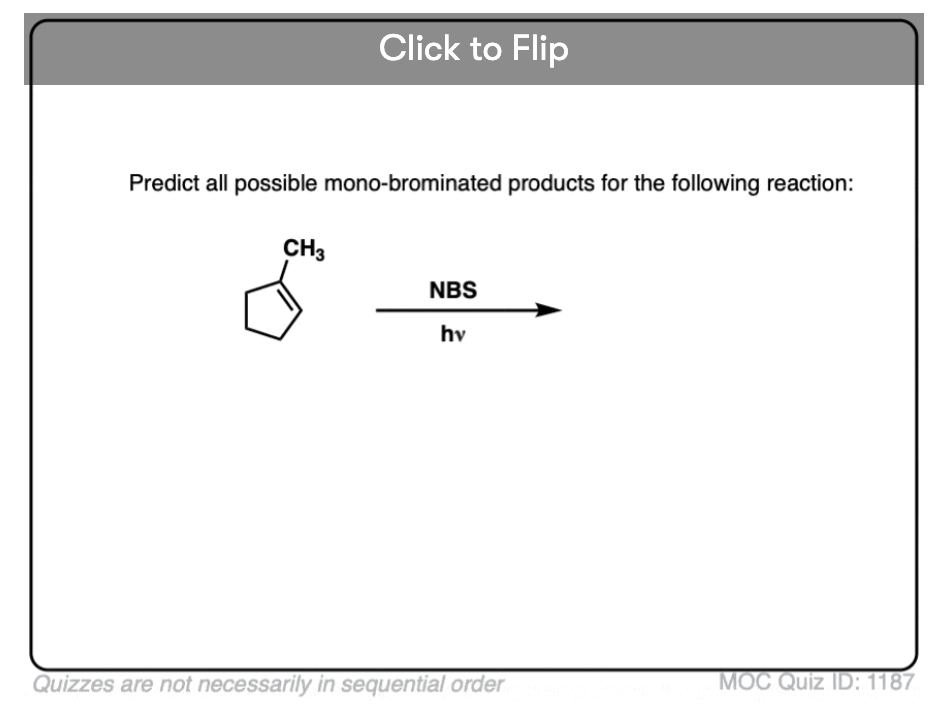
Become a MOC member to see the clickable quiz with answers on the back.

Become a MOC member to see the clickable quiz with answers on the back.

Become a MOC member to see the clickable quiz with answers on the back.
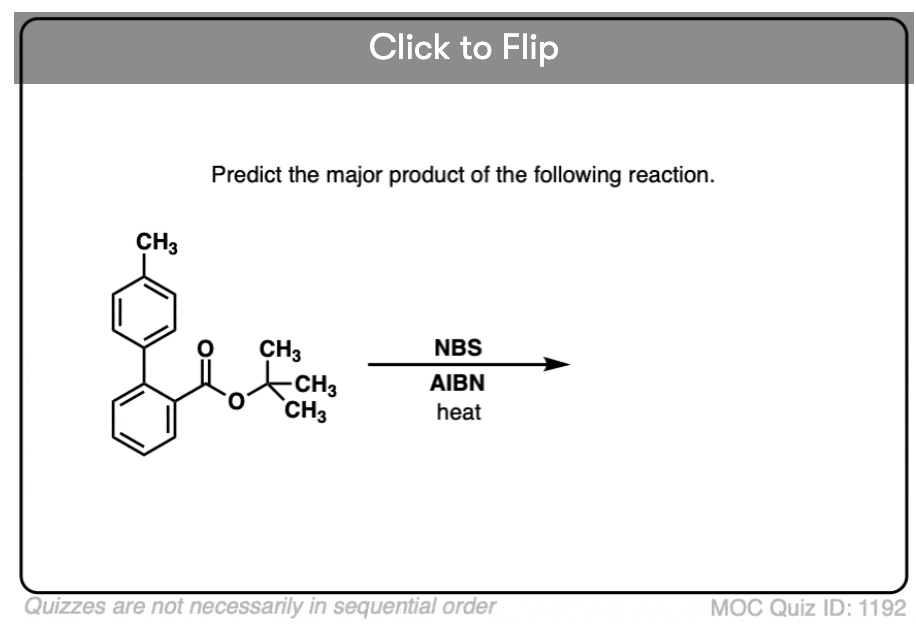
Become a MOC member to see the clickable quiz with answers on the back.
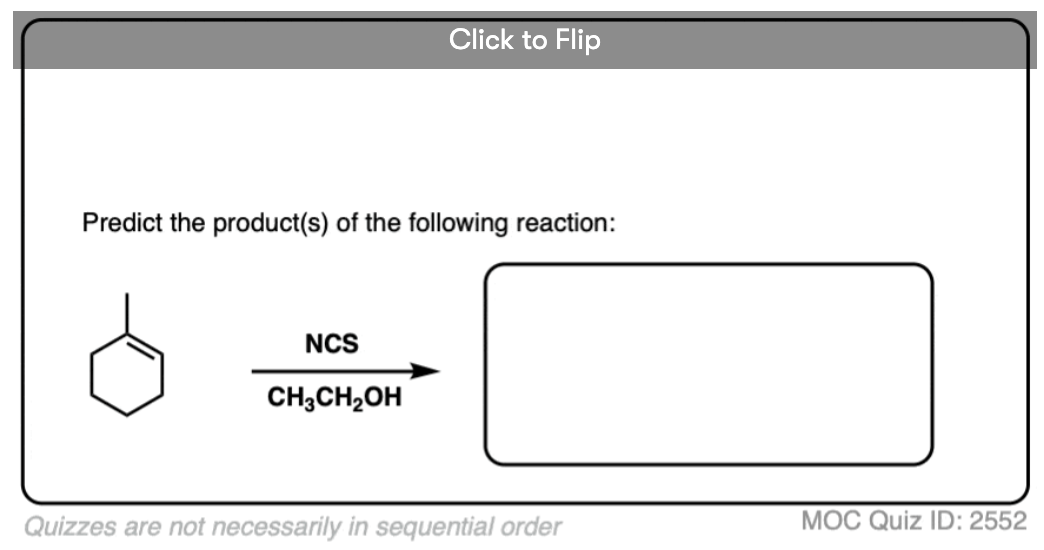
Become a MOC member to see the clickable quiz with answers on the back.
(Advanced) References and Further Reading
-
-
- Bromohydrin formation in dimethyl sulfoxide
David R. Dalton, Ved P. Dutta, and Daniel G. Jones
Journal of the American Chemical Society 1968, 90 (20), 5498-5501
DOI: 10.1021/ja01022a030
The synthesis of halohydrins is commonly taught to undergraduates studying organic chemistry. Bromohydrins can be conveniently formed from alkenes using NBS in moist DMSO.The allylic or benzylic bromination of hydrocarbons using NBS and a radical initiator is also known as the Wohl-Ziegler reaction. - Brominations with N-Bromosuccinimide and Related Compounds. The Wohl-Ziegler Reaction.
Carl Djerassi
Chemical Reviews 1948, 43 (2), 271-317
DOI: 10.1021/cr60135a004
An old review on this reaction by noted chemist Carl Djerassi, whose major contribution to global health was the development of norethindrone – the first female contraceptive. - N-Bromosuccinimide. III. Stereochemical Course of Benzylic Bromination
W. J. Dauben Jr. and Layton L. McCoy
Journal of the American Chemical Society 1959, 81 (20), 5404-5409
DOI: 10.1021/ja01529a038
A mechanistic study on the stereochemistry of benzylic bromination. By observing the formation of racemic benzylic bromides from prochiral substrates, the intermediacy of radicals in this reaction is further strengthened.The same references from allylic bromination can be repurposed here: - Mechanisms of Benzylic Bromination
Glen A. Russell, Charles. DeBoer, and Kathleen M. Desmond
Journal of the American Chemical Society 1963 85 (3), 365-366
DOI: 10.1021/ja00886a040
Benzylic bromination follows the same mechanism as allylic bromination, as this paper explains.NBS is a convenient reagent for free-radical bromination, and the following papers are mechanistic studies involving NBS: - The Mechanism of Benzylic Bromination with N-Bromosuccinimide
R. E. Pearson and J. C. Martin
Journal of the American Chemical Society 1963 85 (3), 354-355
DOI: 10.1021/ja00886a029
These papers by Prof J. C. Martin (UIUC) were early in his career, before he did the work that he is most well-known for (studies on ‘hypervalent’ molecules, including the development of the ‘Dess-Martin Periodinane’). - The Identity of the Chain-Carrying Species in Brominations with N-Bromosuccinimide: Selectivity of Substituted N-Bromosuccinimides toward Substituted Toluenes
R. E. Pearson and J. C. Martin
Journal of the American Chemical Society 1963, 85 (20), 3142-3146
DOI: 10.1021/ja00903a021 - N-bromosuccinimide. Mechanisms of allylic bromination and related reactions
J. H. Incremona and James Cullen Martin
Journal of the American Chemical Society 1970, 92 (3), 627-634
DOI: 10.1021/ja00706a034 - Succinimidyl radical as a chain carrier. Mechanism of allylic bromination
J. C. Day, M. J. Lindstrom, and P. S. Skell
Journal of the American Chemical Society 1974, 96 (17), 5616-5617
DOI: 10.1021/ja00824a074 - Radical Bromination of Cyclohexene in CCl4 by Bromine: Addition versus Substitution
D. W. McMillen and John B. Grutzner
The Journal of Organic Chemistry 1994, 59 (16), 4516-4528
DOI: 10.1021/jo00095a029
This paper describes careful kinetic studies that demonstrate that a low concentration of Br2 (such as that provided by impure NBS) will favor radical substitution over a polar addition reaction. - 4-BROMO-2-HEPTENE
F. L. Greenwood, M. D. Kellert, and J. Sedlak
Org. Synth. Vol. 38, p.8 (1958).
DOI: 10.15227/orgsyn.038.0008
A reliable procedure for allylic bromination with NBS in Organic Syntheses.
- Bromohydrin formation in dimethyl sulfoxide
-
00 General Chemistry Review
01 Bonding, Structure, and Resonance
- How Do We Know Methane (CH4) Is Tetrahedral?
- Hybrid Orbitals and Hybridization
- How To Determine Hybridization: A Shortcut
- Orbital Hybridization And Bond Strengths
- Sigma bonds come in six varieties: Pi bonds come in one
- Dipole Moments and Dipoles
- A Key Skill: How to Calculate Formal Charge
- The Four Intermolecular Forces and How They Affect Boiling Points
- 3 Trends That Affect Boiling Points
- How To Use Electronegativity To Determine Electron Density (and why NOT to trust formal charge)
- Introduction to Resonance
- How To Use Curved Arrows To Interchange Resonance Forms
- Evaluating Resonance Forms (1) - The Rule of Least Charges
- How To Find The Best Resonance Structure By Applying Electronegativity
- Evaluating Resonance Structures With Negative Charges
- Evaluating Resonance Structures With Positive Charge
- Exploring Resonance: Pi-Donation
- Exploring Resonance: Pi-acceptors
- In Summary: Evaluating Resonance Structures
- Drawing Resonance Structures: 3 Common Mistakes To Avoid
- How to apply electronegativity and resonance to understand reactivity
- Bond Hybridization Practice
- Structure and Bonding Practice Quizzes
- Resonance Structures Practice
02 Acid Base Reactions
- Introduction to Acid-Base Reactions
- Acid Base Reactions In Organic Chemistry
- The Stronger The Acid, The Weaker The Conjugate Base
- Walkthrough of Acid-Base Reactions (3) - Acidity Trends
- Five Key Factors That Influence Acidity
- Acid-Base Reactions: Introducing Ka and pKa
- How to Use a pKa Table
- The pKa Table Is Your Friend
- A Handy Rule of Thumb for Acid-Base Reactions
- Acid Base Reactions Are Fast
- pKa Values Span 60 Orders Of Magnitude
- How Protonation and Deprotonation Affect Reactivity
- Acid Base Practice Problems
03 Alkanes and Nomenclature
- Meet the (Most Important) Functional Groups
- Condensed Formulas: Deciphering What the Brackets Mean
- Hidden Hydrogens, Hidden Lone Pairs, Hidden Counterions
- Don't Be Futyl, Learn The Butyls
- Primary, Secondary, Tertiary, Quaternary In Organic Chemistry
- Branching, and Its Affect On Melting and Boiling Points
- The Many, Many Ways of Drawing Butane
- Wedge And Dash Convention For Tetrahedral Carbon
- Common Mistakes in Organic Chemistry: Pentavalent Carbon
- Table of Functional Group Priorities for Nomenclature
- Summary Sheet - Alkane Nomenclature
- Organic Chemistry IUPAC Nomenclature Demystified With A Simple Puzzle Piece Approach
- Boiling Point Quizzes
- Organic Chemistry Nomenclature Quizzes
04 Conformations and Cycloalkanes
- Staggered vs Eclipsed Conformations of Ethane
- Conformational Isomers of Propane
- Newman Projection of Butane (and Gauche Conformation)
- Introduction to Cycloalkanes
- Geometric Isomers In Small Rings: Cis And Trans Cycloalkanes
- Calculation of Ring Strain In Cycloalkanes
- Cycloalkanes - Ring Strain In Cyclopropane And Cyclobutane
- Cyclohexane Conformations
- Cyclohexane Chair Conformation: An Aerial Tour
- How To Draw The Cyclohexane Chair Conformation
- The Cyclohexane Chair Flip
- The Cyclohexane Chair Flip - Energy Diagram
- Substituted Cyclohexanes - Axial vs Equatorial
- Ranking The Bulkiness Of Substituents On Cyclohexanes: "A-Values"
- Cyclohexane Chair Conformation Stability: Which One Is Lower Energy?
- Fused Rings - Cis-Decalin and Trans-Decalin
- Naming Bicyclic Compounds - Fused, Bridged, and Spiro
- Bredt's Rule (And Summary of Cycloalkanes)
- Newman Projection Practice
- Cycloalkanes Practice Problems
05 A Primer On Organic Reactions
- The Most Important Question To Ask When Learning a New Reaction
- Curved Arrows (for reactions)
- Nucleophiles and Electrophiles
- The Three Classes of Nucleophiles
- Nucleophilicity vs. Basicity
- What Makes A Good Nucleophile?
- What Makes A Good Leaving Group?
- 3 Factors That Stabilize Carbocations
- Equilibrium and Energy Relationships
- 7 Factors that stabilize negative charge in organic chemistry
- 7 Factors That Stabilize Positive Charge in Organic Chemistry
- What's a Transition State?
- Hammond's Postulate
- Learning Organic Chemistry Reactions: A Checklist (PDF)
06 Free Radical Reactions
- Free Radical Reactions
- 3 Factors That Stabilize Free Radicals
- Bond Strengths And Radical Stability
- Free Radical Initiation: Why Is "Light" Or "Heat" Required?
- Initiation, Propagation, Termination
- Monochlorination Products Of Propane, Pentane, And Other Alkanes
- Selectivity In Free Radical Reactions
- Selectivity in Free Radical Reactions: Bromination vs. Chlorination
- Halogenation At Tiffany's
- Allylic Bromination
- Bonus Topic: Allylic Rearrangements
- In Summary: Free Radicals
- Synthesis (2) - Reactions of Alkanes
- Free Radicals Practice Quizzes
07 Stereochemistry and Chirality
- Types of Isomers: Constitutional Isomers, Stereoisomers, Enantiomers, and Diastereomers
- How To Draw The Enantiomer Of A Chiral Molecule
- How To Draw A Bond Rotation
- Introduction to Assigning (R) and (S): The Cahn-Ingold-Prelog Rules
- Assigning Cahn-Ingold-Prelog (CIP) Priorities (2) - The Method of Dots
- Enantiomers vs Diastereomers vs The Same? Two Methods For Solving Problems
- Assigning R/S To Newman Projections (And Converting Newman To Line Diagrams)
- How To Determine R and S Configurations On A Fischer Projection
- The Meso Trap
- Optical Rotation, Optical Activity, and Specific Rotation
- Optical Purity and Enantiomeric Excess
- What's a Racemic Mixture?
- Chiral Allenes And Chiral Axes
- Stereochemistry Practice Problems and Quizzes
08 Substitution Reactions
- Nucleophilic Substitution Reactions - Introduction
- Two Types of Nucleophilic Substitution Reactions
- The SN2 Mechanism
- Why the SN2 Reaction Is Powerful
- The SN1 Mechanism
- The Conjugate Acid Is A Better Leaving Group
- Comparing the SN1 and SN2 Reactions
- Polar Protic? Polar Aprotic? Nonpolar? All About Solvents
- Steric Hindrance is Like a Fat Goalie
- Common Blind Spot: Intramolecular Reactions
- Substitution Practice - SN1
- Substitution Practice - SN2
09 Elimination Reactions
- Elimination Reactions (1): Introduction And The Key Pattern
- Elimination Reactions (2): The Zaitsev Rule
- Elimination Reactions Are Favored By Heat
- Two Elimination Reaction Patterns
- The E1 Reaction
- The E2 Mechanism
- E1 vs E2: Comparing the E1 and E2 Reactions
- Antiperiplanar Relationships: The E2 Reaction and Cyclohexane Rings
- Bulky Bases in Elimination Reactions
- Comparing the E1 vs SN1 Reactions
- Elimination (E1) Reactions With Rearrangements
- E1cB - Elimination (Unimolecular) Conjugate Base
- Elimination (E1) Practice Problems And Solutions
- Elimination (E2) Practice Problems and Solutions
10 Rearrangements
11 SN1/SN2/E1/E2 Decision
- Identifying Where Substitution and Elimination Reactions Happen
- Deciding SN1/SN2/E1/E2 (1) - The Substrate
- Deciding SN1/SN2/E1/E2 (2) - The Nucleophile/Base
- SN1 vs E1 and SN2 vs E2 : The Temperature
- Deciding SN1/SN2/E1/E2 - The Solvent
- Wrapup: The Key Factors For Determining SN1/SN2/E1/E2
- Alkyl Halide Reaction Map And Summary
- SN1 SN2 E1 E2 Practice Problems
12 Alkene Reactions
- E and Z Notation For Alkenes (+ Cis/Trans)
- Alkene Stability
- Alkene Addition Reactions: "Regioselectivity" and "Stereoselectivity" (Syn/Anti)
- Stereoselective and Stereospecific Reactions
- Hydrohalogenation of Alkenes and Markovnikov's Rule
- Hydration of Alkenes With Aqueous Acid
- Rearrangements in Alkene Addition Reactions
- Halogenation of Alkenes and Halohydrin Formation
- Oxymercuration Demercuration of Alkenes
- Hydroboration Oxidation of Alkenes
- m-CPBA (meta-chloroperoxybenzoic acid)
- OsO4 (Osmium Tetroxide) for Dihydroxylation of Alkenes
- Palladium on Carbon (Pd/C) for Catalytic Hydrogenation of Alkenes
- Cyclopropanation of Alkenes
- A Fourth Alkene Addition Pattern - Free Radical Addition
- Alkene Reactions: Ozonolysis
- Oxidative Cleavage of Vicinal Diols With NaIO4 and Pb(OAc)4
- Summary: Three Key Families Of Alkene Reaction Mechanisms
- Synthesis (4) - Alkene Reaction Map, Including Alkyl Halide Reactions
- Alkene Reactions Practice Problems
13 Alkyne Reactions
- Acetylides from Alkynes, And Substitution Reactions of Acetylides
- Partial Reduction of Alkynes With Lindlar's Catalyst
- Partial Reduction of Alkynes With Na/NH3 To Obtain Trans Alkenes
- Alkyne Hydroboration With "R2BH"
- Hydration and Oxymercuration of Alkynes
- Hydrohalogenation of Alkynes
- Alkyne Halogenation: Bromination and Chlorination of Alkynes
- Oxidation of Alkynes With O3 and KMnO4
- Alkenes To Alkynes Via Halogenation And Elimination Reactions
- Alkynes Are A Blank Canvas
- Synthesis (5) - Reactions of Alkynes
- Alkyne Reactions Practice Problems With Answers
14 Alcohols, Epoxides and Ethers
- Alcohols - Nomenclature and Properties
- Alcohols Can Act As Acids Or Bases (And Why It Matters)
- Alcohols - Acidity and Basicity
- The Williamson Ether Synthesis
- Ethers From Alkenes, Tertiary Alkyl Halides and Alkoxymercuration
- Alcohols To Ethers via Acid Catalysis
- Cleavage Of Ethers With Acid
- Epoxides - The Outlier Of The Ether Family
- Opening of Epoxides With Acid
- Epoxide Ring Opening With Base
- Making Alkyl Halides From Alcohols
- Tosylates And Mesylates
- PBr3 and SOCl2
- Elimination Reactions of Alcohols
- Elimination of Alcohols To Alkenes With POCl3
- Alcohol Oxidation: "Strong" and "Weak" Oxidants
- Demystifying The Mechanisms of Alcohol Oxidations
- Protecting Groups For Alcohols
- Thiols And Thioethers
- Calculating the oxidation state of a carbon
- Oxidation and Reduction in Organic Chemistry
- Oxidation Ladders
- SOCl2 Mechanism For Alcohols To Alkyl Halides: SN2 versus SNi
- Alcohol Reactions Roadmap (PDF)
- Alcohol Reaction Practice Problems
- Epoxide Reaction Quizzes
- Oxidation and Reduction Practice Quizzes
15 Organometallics
- What's An Organometallic?
- Formation of Grignard and Organolithium Reagents
- Organometallics Are Strong Bases
- Reactions of Grignard Reagents
- Protecting Groups In Grignard Reactions
- Synthesis Problems Involving Grignard Reagents
- Grignard Reactions And Synthesis (2)
- Organocuprates (Gilman Reagents): How They're Made
- Gilman Reagents (Organocuprates): What They're Used For
- The Heck, Suzuki, and Olefin Metathesis Reactions (And Why They Don't Belong In Most Introductory Organic Chemistry Courses)
- Reaction Map: Reactions of Organometallics
- Grignard Practice Problems
16 Spectroscopy
- Degrees of Unsaturation (or IHD, Index of Hydrogen Deficiency)
- Conjugation And Color (+ How Bleach Works)
- Introduction To UV-Vis Spectroscopy
- UV-Vis Spectroscopy: Absorbance of Carbonyls
- UV-Vis Spectroscopy: Practice Questions
- Bond Vibrations, Infrared Spectroscopy, and the "Ball and Spring" Model
- Infrared (IR) Spectroscopy: A Quick Primer On Interpreting Spectra
- IR Spectroscopy: 4 Practice Problems
- 1H NMR: How Many Signals?
- Homotopic, Enantiotopic, Diastereotopic
- Diastereotopic Protons in 1H NMR Spectroscopy: Examples
- 13-C NMR - How Many Signals
- Liquid Gold: Pheromones In Doe Urine
- Natural Product Isolation (1) - Extraction
- Natural Product Isolation (2) - Purification Techniques, An Overview
- Structure Determination Case Study: Deer Tarsal Gland Pheromone
17 Dienes and MO Theory
- What To Expect In Organic Chemistry 2
- Are these molecules conjugated?
- Conjugation And Resonance In Organic Chemistry
- Bonding And Antibonding Pi Orbitals
- Molecular Orbitals of The Allyl Cation, Allyl Radical, and Allyl Anion
- Pi Molecular Orbitals of Butadiene
- Reactions of Dienes: 1,2 and 1,4 Addition
- Thermodynamic and Kinetic Products
- More On 1,2 and 1,4 Additions To Dienes
- s-cis and s-trans
- The Diels-Alder Reaction
- Cyclic Dienes and Dienophiles in the Diels-Alder Reaction
- Stereochemistry of the Diels-Alder Reaction
- Exo vs Endo Products In The Diels Alder: How To Tell Them Apart
- HOMO and LUMO In the Diels Alder Reaction
- Why Are Endo vs Exo Products Favored in the Diels-Alder Reaction?
- Diels-Alder Reaction: Kinetic and Thermodynamic Control
- The Retro Diels-Alder Reaction
- The Intramolecular Diels Alder Reaction
- Regiochemistry In The Diels-Alder Reaction
- The Cope and Claisen Rearrangements
- Electrocyclic Reactions
- Electrocyclic Ring Opening And Closure (2) - Six (or Eight) Pi Electrons
- Diels Alder Practice Problems
- Molecular Orbital Theory Practice
18 Aromaticity
- Introduction To Aromaticity
- Rules For Aromaticity
- Huckel's Rule: What Does 4n+2 Mean?
- Aromatic, Non-Aromatic, or Antiaromatic? Some Practice Problems
- Antiaromatic Compounds and Antiaromaticity
- The Pi Molecular Orbitals of Benzene
- The Pi Molecular Orbitals of Cyclobutadiene
- Frost Circles
- Aromaticity Practice Quizzes
19 Reactions of Aromatic Molecules
- Electrophilic Aromatic Substitution: Introduction
- Activating and Deactivating Groups In Electrophilic Aromatic Substitution
- Electrophilic Aromatic Substitution - The Mechanism
- Ortho-, Para- and Meta- Directors in Electrophilic Aromatic Substitution
- Understanding Ortho, Para, and Meta Directors
- Why are halogens ortho- para- directors?
- Disubstituted Benzenes: The Strongest Electron-Donor "Wins"
- Electrophilic Aromatic Substitutions (1) - Halogenation of Benzene
- Electrophilic Aromatic Substitutions (2) - Nitration and Sulfonation
- EAS Reactions (3) - Friedel-Crafts Acylation and Friedel-Crafts Alkylation
- Intramolecular Friedel-Crafts Reactions
- Nucleophilic Aromatic Substitution (NAS)
- Nucleophilic Aromatic Substitution (2) - The Benzyne Mechanism
- Reactions on the "Benzylic" Carbon: Bromination And Oxidation
- The Wolff-Kishner, Clemmensen, And Other Carbonyl Reductions
- More Reactions on the Aromatic Sidechain: Reduction of Nitro Groups and the Baeyer Villiger
- Aromatic Synthesis (1) - "Order Of Operations"
- Synthesis of Benzene Derivatives (2) - Polarity Reversal
- Aromatic Synthesis (3) - Sulfonyl Blocking Groups
- Birch Reduction
- Synthesis (7): Reaction Map of Benzene and Related Aromatic Compounds
- Aromatic Reactions and Synthesis Practice
- Electrophilic Aromatic Substitution Practice Problems
20 Aldehydes and Ketones
- What's The Alpha Carbon In Carbonyl Compounds?
- Nucleophilic Addition To Carbonyls
- Aldehydes and Ketones: 14 Reactions With The Same Mechanism
- Sodium Borohydride (NaBH4) Reduction of Aldehydes and Ketones
- Grignard Reagents For Addition To Aldehydes and Ketones
- Wittig Reaction
- Hydrates, Hemiacetals, and Acetals
- Imines - Properties, Formation, Reactions, and Mechanisms
- All About Enamines
- Breaking Down Carbonyl Reaction Mechanisms: Reactions of Anionic Nucleophiles (Part 2)
- Aldehydes Ketones Reaction Practice
21 Carboxylic Acid Derivatives
- Nucleophilic Acyl Substitution (With Negatively Charged Nucleophiles)
- Addition-Elimination Mechanisms With Neutral Nucleophiles (Including Acid Catalysis)
- Basic Hydrolysis of Esters - Saponification
- Transesterification
- Proton Transfer
- Fischer Esterification - Carboxylic Acid to Ester Under Acidic Conditions
- Lithium Aluminum Hydride (LiAlH4) For Reduction of Carboxylic Acid Derivatives
- LiAlH[Ot-Bu]3 For The Reduction of Acid Halides To Aldehydes
- Di-isobutyl Aluminum Hydride (DIBAL) For The Partial Reduction of Esters and Nitriles
- Amide Hydrolysis
- Thionyl Chloride (SOCl2) And Conversion of Carboxylic Acids to Acid Halides
- Diazomethane (CH2N2)
- Carbonyl Chemistry: Learn Six Mechanisms For the Price Of One
- Making Music With Mechanisms (PADPED)
- Carboxylic Acid Derivatives Practice Questions
22 Enols and Enolates
- Keto-Enol Tautomerism
- Enolates - Formation, Stability, and Simple Reactions
- Kinetic Versus Thermodynamic Enolates
- Aldol Addition and Condensation Reactions
- Reactions of Enols - Acid-Catalyzed Aldol, Halogenation, and Mannich Reactions
- Claisen Condensation and Dieckmann Condensation
- Decarboxylation
- The Malonic Ester and Acetoacetic Ester Synthesis
- The Michael Addition Reaction and Conjugate Addition
- The Robinson Annulation
- Haloform Reaction
- The Hell–Volhard–Zelinsky Reaction
- Enols and Enolates Practice Quizzes
23 Amines
- The Amide Functional Group: Properties, Synthesis, and Nomenclature
- Basicity of Amines And pKaH
- 5 Key Basicity Trends of Amines
- The Mesomeric Effect And Aromatic Amines
- Nucleophilicity of Amines
- Alkylation of Amines (Sucks!)
- Reductive Amination
- The Gabriel Synthesis
- Some Reactions of Azides
- The Hofmann Elimination
- The Hofmann and Curtius Rearrangements
- The Cope Elimination
- Protecting Groups for Amines - Carbamates
- The Strecker Synthesis of Amino Acids
- Introduction to Peptide Synthesis
- Reactions of Diazonium Salts: Sandmeyer and Related Reactions
- Amine Practice Questions
24 Carbohydrates
- D and L Notation For Sugars
- Pyranoses and Furanoses: Ring-Chain Tautomerism In Sugars
- What is Mutarotation?
- Reducing Sugars
- The Big Damn Post Of Carbohydrate-Related Chemistry Definitions
- The Haworth Projection
- Converting a Fischer Projection To A Haworth (And Vice Versa)
- Reactions of Sugars: Glycosylation and Protection
- The Ruff Degradation and Kiliani-Fischer Synthesis
- Isoelectric Points of Amino Acids (and How To Calculate Them)
- Carbohydrates Practice
- Amino Acid Quizzes
25 Fun and Miscellaneous
- A Gallery of Some Interesting Molecules From Nature
- Screw Organic Chemistry, I'm Just Going To Write About Cats
- On Cats, Part 1: Conformations and Configurations
- On Cats, Part 2: Cat Line Diagrams
- On Cats, Part 4: Enantiocats
- On Cats, Part 6: Stereocenters
- Organic Chemistry Is Shit
- The Organic Chemistry Behind "The Pill"
- Maybe they should call them, "Formal Wins" ?
- Why Do Organic Chemists Use Kilocalories?
- The Principle of Least Effort
- Organic Chemistry GIFS - Resonance Forms
- Reproducibility In Organic Chemistry
- What Holds The Nucleus Together?
- How Reactions Are Like Music
- Organic Chemistry and the New MCAT
26 Organic Chemistry Tips and Tricks
- Common Mistakes: Formal Charges Can Mislead
- Partial Charges Give Clues About Electron Flow
- Draw The Ugly Version First
- Organic Chemistry Study Tips: Learn the Trends
- The 8 Types of Arrows In Organic Chemistry, Explained
- Top 10 Skills To Master Before An Organic Chemistry 2 Final
- Common Mistakes with Carbonyls: Carboxylic Acids... Are Acids!
- Planning Organic Synthesis With "Reaction Maps"
- Alkene Addition Pattern #1: The "Carbocation Pathway"
- Alkene Addition Pattern #2: The "Three-Membered Ring" Pathway
- Alkene Addition Pattern #3: The "Concerted" Pathway
- Number Your Carbons!
- The 4 Major Classes of Reactions in Org 1
- How (and why) electrons flow
- Grossman's Rule
- Three Exam Tips
- A 3-Step Method For Thinking Through Synthesis Problems
- Putting It Together
- Putting Diels-Alder Products in Perspective
- The Ups and Downs of Cyclohexanes
- The Most Annoying Exceptions in Org 1 (Part 1)
- The Most Annoying Exceptions in Org 1 (Part 2)
- The Marriage May Be Bad, But the Divorce Still Costs Money
- 9 Nomenclature Conventions To Know
- Nucleophile attacks Electrophile
27 Case Studies of Successful O-Chem Students
- Success Stories: How Corina Got The The "Hard" Professor - And Got An A+ Anyway
- How Helena Aced Organic Chemistry
- From a "Drop" To B+ in Org 2 – How A Hard Working Student Turned It Around
- How Serge Aced Organic Chemistry
- Success Stories: How Zach Aced Organic Chemistry 1
- Success Stories: How Kari Went From C– to B+
- How Esther Bounced Back From a "C" To Get A's In Organic Chemistry 1 And 2
- How Tyrell Got The Highest Grade In Her Organic Chemistry Course
- This Is Why Students Use Flashcards
- Success Stories: How Stu Aced Organic Chemistry
- How John Pulled Up His Organic Chemistry Exam Grades
- Success Stories: How Nathan Aced Organic Chemistry (Without It Taking Over His Life)
- How Chris Aced Org 1 and Org 2
- Interview: How Jay Got an A+ In Organic Chemistry
- How to Do Well in Organic Chemistry: One Student's Advice
- "America's Top TA" Shares His Secrets For Teaching O-Chem
- "Organic Chemistry Is Like..." - A Few Metaphors
- How To Do Well In Organic Chemistry: Advice From A Tutor
- Guest post: "I went from being afraid of tests to actually looking forward to them".
1- Concerning the formation of a Bromohydrin, the reaction does not pass by radicals, does it ?
2- Could you propose a transition state of the reaction ?
No it does not pass through a free radical.
For NBS substitution over allylic and benzylic substitution, is the rearrangement of free radical allowed or not???
I’m not precisely sure what you’re asking. Could you be more specific – perhaps give an example?
Do stearic hinderance also comes to concern while reaction with NBS.
Which specific reaction with NBS?
Can we carry out mono bromination of quinone species using NBS as reagent?
Please answer
Probably. Especially if acid catalysis is used. https://pubs.acs.org/doi/10.1021/ol006952r
Toluene reacted with NBS yields p-bromotoluene, o-bromotoluene, and small amounts of m-bromotoluene…in your example you show it yields the bromine bonded to the methyl in the allylic position. I conducted this reaction in lab last week and FTIR and NMR confirmed the products I listed above. Confused as to how you came to that product?
Hydrogen peroxide and bromine also gives radical bromine why does only n bromo succinamide give allylic product
Bromine will lead to bromination of the double bond. NBS provides a stable, low-concentration source of Br2. See this post. https://www.masterorganicchemistry.com/2013/11/25/allylic-bromination/
Amazing! You should be a prof at my college!!!
Thank you Anonymous
into what is nbs converted as it reacts in allylic bromination reactions?
– i thought it would be bromine but that is incorrect. Could it be bromine radical ?
Eventually NBS is converted into succinimide.
Why low concentration of Br2 => substitution, high concentration of Br2 => addition?
See this post on allylic bromination: https://www.masterorganicchemistry.com/2013/11/25/allylic-bromination/
James,
NBS generates a bromine radical which then abstracts the allylic Hydrogen on propene because the allylic c-h bond is the weakest c-h bond due to resonance of the resulting allylic radical.
However, I was also taught that bromine radicals generated from hbr reacting with RO radicals (generated by homolytic cleavage of a peroxide bond) will react with the pi bond generating the 1-broom-2-propyl radical as a propagation step of antimarkovnikov addition of hbr in the presence of peroxides.
So where do br radicals react, at the pi bond or at the allylic c—h bond?
The radicals will add to the double bond, but the radical created by that (carbon-based radical) needs something to react with to continue the chain reaction. When HBr is present, it reacts with H-Br to regenerate Br• and the cycle continues. However with allylic bromination, there isn’t a source of HBr present that can continue the chain. Therefore if radical addition happens, it just reverts back to the double bond and bromine radical. In other words, addition to the double bond is a dead end.
What happens if you have NBS/ROOR?
That will likely be an allylic bromination.
Can NBS be used as a reagent in an electrophilic aromatic substitution halogenation reaction ?
Yes, but typically only with very electron-rich aromatic species like pyrrole, indole, and furan. NBS plus benzene won’t get you much without a Lewis acid catalyst.
does it react with cyclohexane? or primary amine or alchohol?
Cyclohexane, no. Primary amines / alcohols – yes, forming weak N-Br or O-Br bonds that themselves can be oxidants or undergo a variety of complex reactions.
Does NBS oxidise primary alcohols to aldehyde?
Yes, it will oxidize primary alcohols to aldehydes in polar solvents through forming a hypobromite intermediate. Interestingly, NBS is more selective for secondary over primary alcohols, and also very selective for oxidation of axial (vs equatorial) groups in steroid systems. See Chem. Rev. 1963, vol 63 page 21. https://pubs.acs.org/doi/10.1021/cr60221a002
What Is the mechanism if we react cyclohex1-ene with NBS and heat
Allylic bromination, as mentioned in this post: https://www.masterorganicchemistry.com/2013/11/25/allylic-bromination/
What does NBS do if we take any peroxide with it?
In the presence of peroxides, NBS will do allylic or benzylic bromination.
Is NBS used to make halogen compound without disturbing the double bond ?
It can perform allylic bromination or benzylic bromination in the presence of peroxides, without disturbing the double bond, yes.
regarding your statement in “NBS (N-Bromo Succinimide)”
“Secondly, it’s extremely dense (d=3.19) and therefore drops of it tend to fall from whatever you’re using to dispense it with, Jackson Pollock style, leaving little violently fuming orange puddles behind.” The reason for this is not density, but bromine’s high vapor pressure. Drawing it into a pipet immediately expels it because the pressure builds in the pipet. Even the warmth of your hand on a pipet filled with bromine will pressurize the pipet and expel the bromine.
Great point Fred. Thank you for clarifying that!
Well written and easy to read!
How about mono-bromination of cyclopentylphenylmethanone to (1-bromo-cyclopentyl)-phenyl-methanone ?
Using n-bromo succinimide?
I wanted to insert images into this post but it does not seem possible to do so.
Thanks for your attention!
Will NBS brominate norbornadiene or triptycene at the bridgehead carbon? Is there a published precedent for this?
Thanks
Possibly. I’m aware of N-chloro dialkylamines doing bridgehead chlorinations, see J. Am. Chem. Soc.1974 96 134307-4311 . https://pubs.acs.org/doi/10.1021/ja00820a042
Does the radical intermediate undergo rearrangement to form a more stable free radical (if possible) , I have read that radicals have little tendency to rearrange unlike carbocations,
But since the radical here is in conjugation with the double bond, shouldnt there be rearrangement (because of the contribution of second canonical form)
Hi, they don’t undergo H or alkyl shifts like carbocations do, but they do undergo allylic rearrangements. https://www.masterorganicchemistry.com/2013/12/02/bonus-topic-allylic-rearrangements/
When 4-methyl-hex-2-ene reacts with NBS, you get two products. How do you know which of the products is the major product? My teacher has 2-bromo-4-methyl-hex-3-ene as the major product.
Hi – that’s not an easy question to answer. Often the product depends delicately on the reaction conditions, especially the temperature. I would certainly expect that the hydrogen on C-3 is abstracted first (as opposed to C-1) giving a tertiary allylic radical (vs. a primary allylic radical) but where the c-Br bond forms is hard to predict. One thing to note is that forming the C-3 C4 double bond is more substituted (more stable) than the C2-C3 double bond (less substituted, less stable) and higher temperatures would tend to favor that product.
I don’t have a simple answer for you unfortunately. Thanks for writing, James
Is it possible to carry out electrophilic aromatic substitutions using NBS as the brominating agent like we do with Br2?
Belated to answer your question but yes, Lewis acids are compatible with NBS and make it more reactive. It can be used to brominate aromatics. Usually works best for electron rich aromatics like phenol and pyrrole. For electron poor species I’d stick with Br2 and FeBr3 or similar.
Sorry for the late response, hope it’s helpful James
Very helpful! Thank you!
weird, i didn’t know peyton manning had his PhD in organic chemistry…
Great! Exactly what I was looking for and explained beautifully.
“The advantage of Br2 is that it provides a low-level concentration of Br2″… It should read “The advantage of NBS is that it provides a low-level concentration of Br2″…
Fixed. Thanks for the correction!
When cyclohexanone reacts with NBS/CCl4 +aq KOH we get cyclopentanoic acid as final product .I found this on a test. Can you please tell me what happened here
Alpha bromination followed by Favorskii rearrangement.